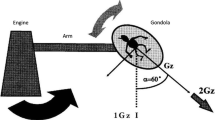Abstract
Serial changes in catecholamine (CA) and cortisol (Col) concentrations of human subjects exposed to acceleration stress with the vector in the head-foot direction (+ 5Gz for 1 min) were determined using a newly designed continuous blood sampling system. The results demonstrated that the time course changes in noradrenaline (NA), adrenaline (A) and Col concentrations were quite different from each other during and after the Gz exposure. The NA remained relatively unchanged during the exposure, and showed a marked increase at the end of the exposure, peaking at about 110 s after the end of the exposure. The A showed a gradual increase from the start of the exposure and continued to rise during and after the exposure. Its maximal peak was also found at about 110 s after the exposure. The A showed a sevenfold increase, while NA showed only about a threefold increase as high as pre-exposure levels. The more rapid and greater magnitude of increase in A concentration during exposure may have reflected the larger emotional stress and strenuous physical activities involved in the Gz exposure. Heart rate showed a rapid increase upon exposure and remained significantly increased during the exposure; it then showed a transient fall immediately after the exposure, despite the increase in CA. An interesting observation was a decrease in Col during the Gz exposure. A plausible explanation would appear to be the result of an enhanced rate of Col removal from the plasma. From these observations, the importance of serial determination of hormonal excretion during Gz stress for the precise analysis of hormonal response to Gz stress was confirmed.
Similar content being viewed by others
References
Burns JW, Laughlin MH, Witt WM, Young JT, Ellis JP, Jr (1983) Pathophysiologic effects of acceleration stress in the miniature swine. Aviat Space Environ Med 54:881–893
Burton RR, Mackenzie WF (1976) Cardiac pathology associated with high sustained +Gz: 1. Subendocardial hemorrhage. Aviat Space Environ Med 47:711–717
Collins KJ, Few JD, Forward TJ, Giec LA (1969) Stimulation of adrenal glucocorticoid secretion in man by raising the body temperature. J Physiol (Lond) 202:645–660
Dallman ME, Yates FE (1969) Dynamic asymmetries in the corticosteroid feedback path and distribution-metabolism-binding elements of the adrenocortical system. Ann NY Acad Sci 156:696–721
Few JD (1974) Effect of exercise on the secretion and metabolism of cortisol in man. J Endocrinol 62:341–353
Forster EM (1994) Heart rate response of aircrew during recovery from gradual onset rate +Gz exposures. Aviat Space Environ Med 65:55–59
Goodall MC, Meehan JP (1956) Correlation of “g” tolerance to urinary adrenaline and noradrenaline. Am J Physiol 187:601
Greenleaf JE, Brock PJ, Sciaraffa D, Polese A, Elizondo R (1985) Effects of exercise-heat acclimation on fluid, electrolyte, and endocrine responses during tilt and +Gz acceleration in women and men. Aviat Space Environ Med 56:683–689
Kindermann W, Schnabel A, Schmitt WM, Biro G, Cassens J, Weber F (1982) Catecholamines, growth hormone, cortisol, insulin, and sex hormones in anaerobic and aerobic exercise. Eur J Appl Physiol 49:389–399
Mills FJ (1983) The effect of sustained + Gz acceleration upon endocrine function. Thesis, University of Surrey, Guildford
Mills FJ (1985) The endocrinology of stress. Aviat Space Environ Med 56:642–650
Mills FJ, Marks V (1982) Human endocrine responses to acceleration stress. Aviat Space Environ Med 53:537–540
Miyamoto Y, Shimazu H, Kawarada A, Tarui H, Ito H (1991) Automatic blood sampling system (in Japanese). Report 32(1/2) pp 23–27, Aeromedical Laboratory, Japan Air Self Defense Force, Tokyo
Mori K (1981) Automated measurement of catecholamines in urine, plasma and tissue homogenates by high-performance liquid chromatography with fluorometric detection J Chromatogr 218:631–637
Sakauchi M (1991) Determination of catecholamines in human plasma (in Japanese). Report JASDF 32(3) pp 105–12 Aeromedical Laboratory Japan Air Self Defense Force, Tokyo
Smedes F, Kraak JC, Poppe H (1982) Simple and fast solvent extraction system for selective and quantitative isolation of adrenaline, noradrenarine and dopamine from plasma and urine. J Chromatogr 231:25–39
Sutton JR, Young JD, Lazarus L, Hickie JB, Maksvytis J (1969) The hormonal response to physical exercise. Ann Med 18:84–90
Tarui H, Nakamura A (1987) Saliva cortisol: a good indicator for acceleration stress. Aviat Space Environ Med 58:573–575
Whinnery JE (1990) The electrocardiographic response to high +Gz centrifuge training. Aviat Space Environ Med 61:716–721
Author information
Authors and Affiliations
Rights and permissions
About this article
Cite this article
Miyamoto, Y., Shimazu, H. & Nakamura, A. Plasma catecholamine and cortisol concentrations during acceleration stress. Europ. J. Appl. Physiol. 70, 407–412 (1995). https://doi.org/10.1007/BF00618491
Accepted:
Issue Date:
DOI: https://doi.org/10.1007/BF00618491




